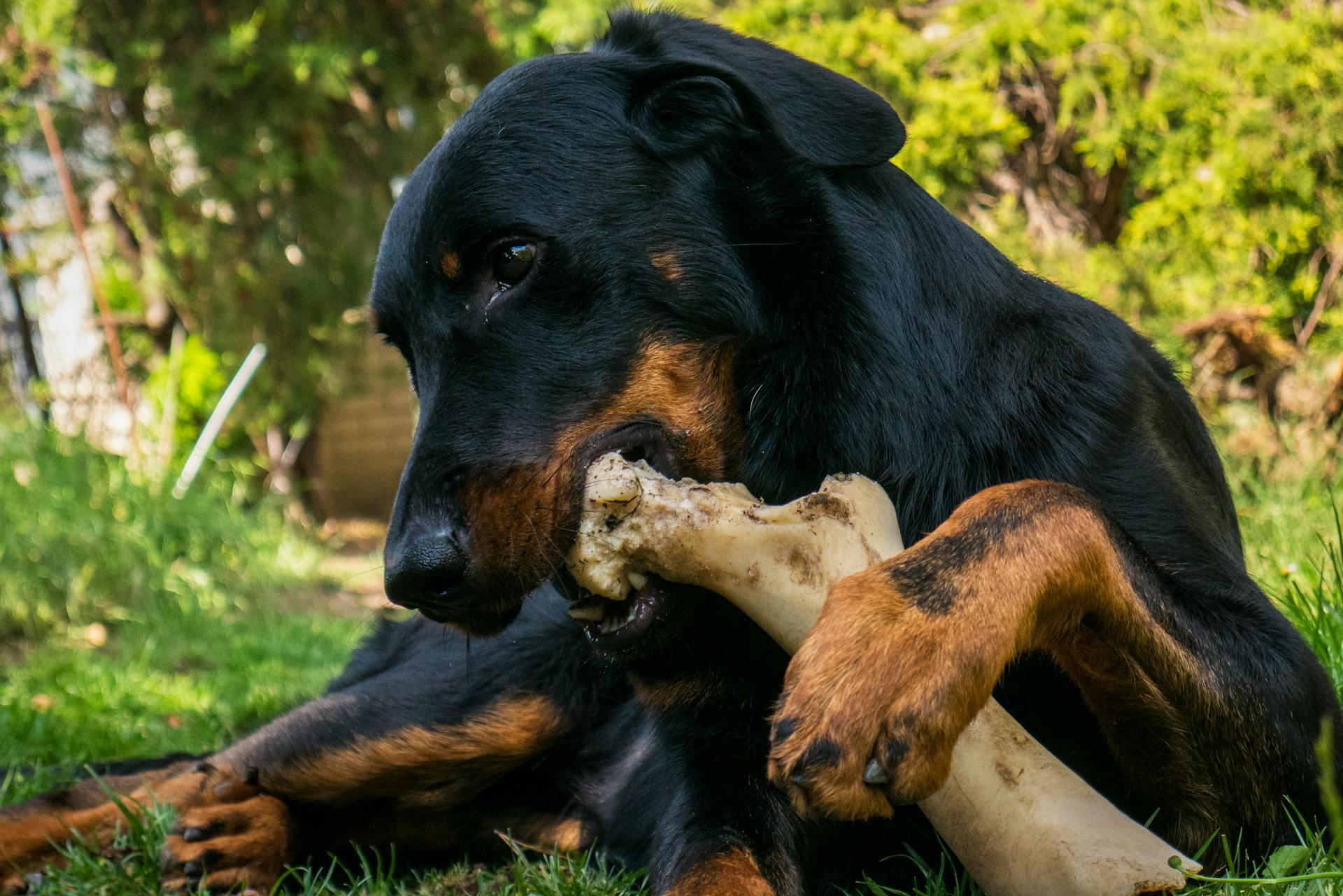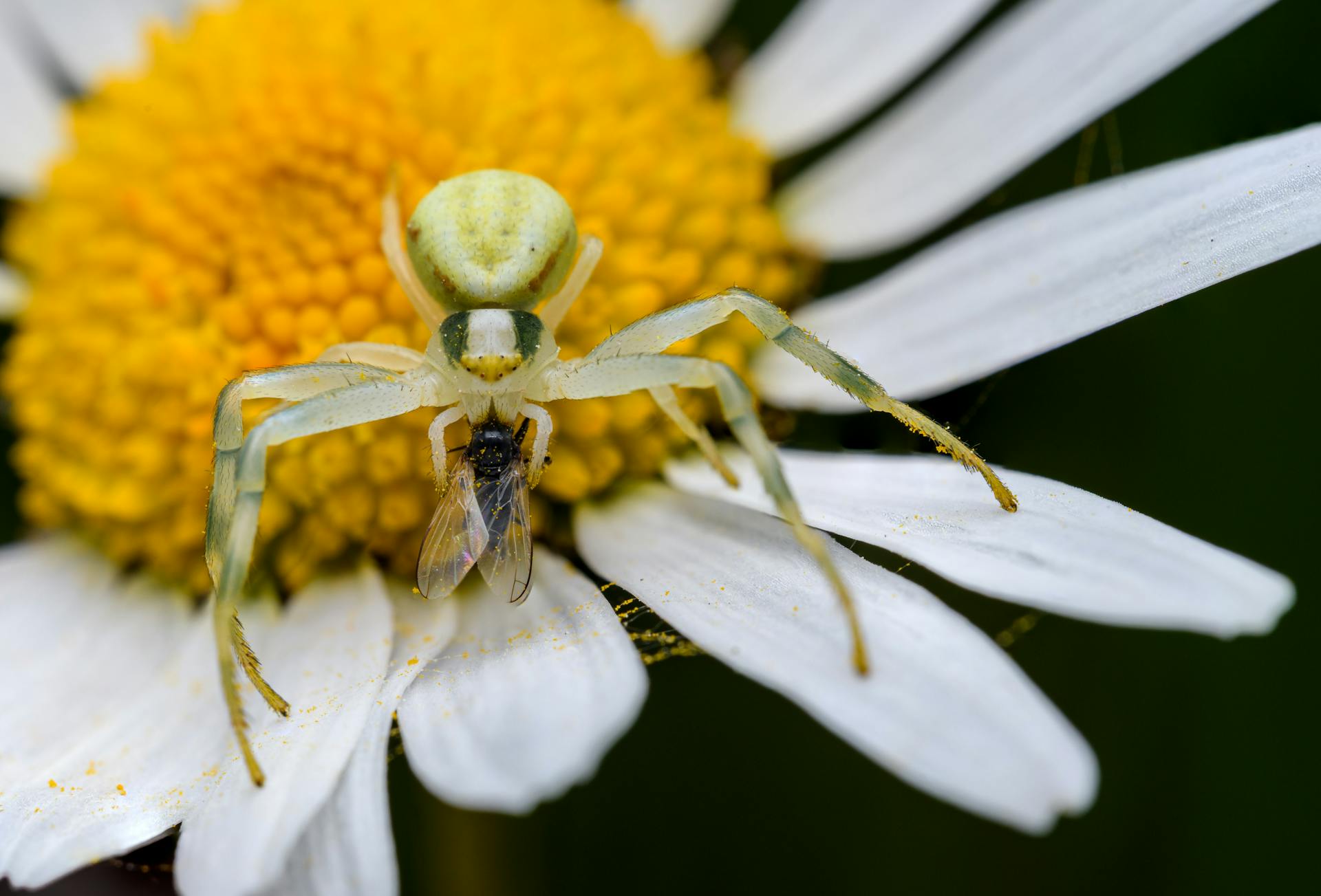
Rottweilers are often misunderstood, but their bite can be a serious issue. They have a strong jaw and powerful bite force, capable of exerting up to 328 pounds per square inch.
Their bite is often described as a "grip and hold" type of bite, where they lock their jaws onto their prey. This grip is so strong that it can cause severe injuries.
Rottweilers are also known to be one of the breeds most often involved in fatal dog attacks. According to the American Veterinary Medical Association, Rottweilers are responsible for 8.4% of all dog bites that result in fatalities.
Their aggressive behavior is often linked to their high energy levels and lack of proper training.
For your interest: How Often Do Rottweilers Go into Heat
Safety and Prevention
Rottweilers possess a significant bite force, which necessitates responsible ownership to ensure safety.
A Rottweiler's bite force can deliver dangerous injuries in an instant, with a powerful bite force of 328 psi. This is a crucial fact to consider when thinking about owning a Rottweiler.
Proper training and socialization from an early age are essential in preventing dog bites. This is because a Rottweiler may instinctively act to protect its territory or family, so it is crucial to train them to recognize non-threatening situations.
Establishing clear boundaries and consistent training routines can reduce the risk of unexpected aggression. This is because routine training reinforces commands and expectations, thereby reducing the risk of unexpected aggression.
Here are some key tips for preventing dog bites:
- Establish clear boundaries: Teach your Rottweiler where it can and cannot go, and what behaviors are unacceptable.
- Consistent training routines: Routine training reinforces commands and expectations, thereby reducing the risk of unexpected aggression.
- Socialization: Expose your dog to various people, animals, and environments to reduce fear and aggressive reactions.
When out in public, be aware of your surroundings and avoid approaching dogs you don’t know. A Rottweiler may bite if it feels threatened or scared, even if it's a friendly dog.
Handling Aggressive Situations
If you encounter an aggressive Rottweiler, it's essential to stay calm and avoid sudden movements. This can help prevent the situation from escalating.
Speak to the dog calmly and try to redirect its attention to something else. This can be as simple as offering a treat or toy.
If the dog is still aggressive, it's crucial to back away slowly and leave the area. Don't try to approach the dog or block its path.
Identifying the trigger for the dog's aggression is also important. This could be another dog, a person, or an object. Once you know what's causing the aggression, you can try to avoid it or desensitize the dog to it.
Here are some steps to take if you're unable to handle the aggression yourself:
- Seek professional help from a dog trainer or behaviorist
- If you're bitten, seek medical attention immediately
Remember, aggression is a serious behavior problem that shouldn't be ignored. If you're unsure of how to handle an aggressive Rottweiler, it's always best to err on the side of caution and seek help.
Bitten: What to Do
If you've been bitten by a Rottweiler, it's essential to take immediate action to reduce the risk of infection and promote speedy healing.
Clean the wound by rinsing it with soap and warm water for at least five minutes to remove dirt or bacteria. Cover the bite with a clean, dry bandage.
Apply pressure with a clean cloth or bandage if the wound is bleeding, and elevate the affected area if possible to help reduce swelling.
Seek medical attention, even if the wound seems minor, to assess the injury and determine if further treatment, such as antibiotics or a tetanus shot, is needed.
If the wound is deep, you may need stitches or other medical care. It's always better to err on the side of caution and seek professional help.
Report the bite to your local animal control agency if the dog that bit you is a stray or you don't know its owner. This will help identify the dog and prevent it from biting someone else.
Here's a summary of the steps to take if you've been bitten by a Rottweiler:
- Clean the wound
- Apply first aid
- Seek medical attention
- Report the bite
- Speak to an attorney (if necessary)
Rottweiler's Bite Force and Training
Rottweilers have a powerful bite force of 328 PSI, which is a key factor in their reputation as effective guard dogs. This is due to their strong jaw and wide skull, which houses large, strong teeth and powerful neck muscles.
Proper training and behavior modification are crucial in managing a Rottweiler's bite force and ensuring they are safe family pets and effective guard dogs. Responsible breeding, training, and socialization are essential in ensuring that this powerful trait is managed correctly and safely.
Through training, a Rottweiler can learn to moderate its bite. Key strategies include bite inhibition, using appropriate toys, and positive reinforcement. By teaching a Rottweiler to control the strength of its bite from a young age, owners can redirect biting behavior and provide an outlet for the dog's natural chewing instinct.
Rottweiler's Bite Force
Rottweiler's bite force is a measure of the strength of their jaws, typically gauged in pounds per square inch (PSI). This is a crucial aspect of their anatomy and behavior, especially when it comes to their role as guard dogs.
Rottweilers have a strong jaw with a wide skull that houses large, strong teeth, and powerful neck muscles, all contributing to their notable bite force of 328 PSI. This is a key factor in their effectiveness as guard dogs and cattle drovers.
Consider reading: Are Rottweilers Good Protection Dogs
Bite force is quantified using specialized instruments, such as bite sleeves or bite meters, designed to withstand significant forces while safeguarding handlers during measurement. The average dog bite force is around 230 to 250 PSI.
Rottweilers are competitive in terms of bite force, yet surpassed by specific breeds such as the Cane Corso, which has a bite force of approximately 700 PSI. The Rottweiler's bite force is also comparable to that of the American Bulldog, which typically exhibits a bite force of about 305 PSI.
In measuring bite force, researchers utilize instruments that can withstand significant forces, ensuring accuracy while safeguarding handlers. This is particularly important when working with breeds known for their powerful bite force, such as the Rottweiler.
Here's a comparison of the bite forces of various guard dog breeds:
Impact of Training
Proper training is essential in managing a Rottweiler's bite force. It shapes their protective nature into a controllable trait, making them safe family pets and effective guard dogs.
A Rottweiler's naturally strong bite can be a liability if not properly managed. Effective obedience training is key to ensuring the dog knows when to use its bite force in appropriate situations.
Training a Rottweiler can significantly impact its bite force control. Trained Rottweilers learn to modulate their bite and demonstrate restraint, rather than using their full bite force during play or when a perceived threat is neutralized.
Key strategies for training a Rottweiler to moderate its bite include bite inhibition, using appropriate toys, and positive reinforcement. By rewarding gentle behavior, owners can reinforce that gentle behavior is desirable.
Here are some specific training strategies to help your Rottweiler learn to moderate its bite:
- Bite inhibition: Teach your Rottweiler to control the strength of its bite from a young age, usually during play.
- Using appropriate toys: Encourage the use of chew toys to redirect biting behavior and provide an outlet for the dog's chewing instinct.
- Positive reinforcement: Reward your Rottweiler when it displays gentle behavior.
Rottweiler Breed and History
Rottweilers are a large and muscular breed known for their strength and loyalty, which can make them a dangerous dog. They often serve as working dogs.
Their deep history reflects their versatility, with a possible descent from Roman drover dogs. They were reliable messenger dogs during both World Wars.
Rottweilers are a popular breed among dog enthusiasts due to their intelligence and versatility as a working dog. They can be affectionate and are sometimes referred to as “gentle giants.”
Discover more: What Was Rottweilers Bred for
The Rottweiler Breed
The Rottweiler Breed is a large and muscular breed known for their strength and loyalty. They often serve as working dogs.
Rottweilers have a deep history that reflects their versatility. Their powerful build and strong work ethic have made them a valuable asset in various roles.
Rottweilers are bred to act as guard dogs, which means they have a powerful bite force of 328 psi. This can deliver dangerous injuries in an instant.
Dogs with shorter, wider heads, like Rottweilers, bite more often. The strength of their jaw muscles and their unwillingness to relinquish after a bite is part of what makes their bites so dangerous.
History and Origin
The Rottweiler breed has a rich history that dates back to ancient times. They are one of the oldest herding breeds, with possible roots from Roman drover dogs.
Their versatility as a working dog has made them a popular choice among dog enthusiasts. They were used as reliable messenger dogs during both World Wars.
The breed was officially recognized by the American Kennel Club (AKC) in 1931. This marked a significant milestone in their development as a distinct breed.
Rottweilers were named after the German town of Rottweil, where they were used to drive cattle and pull carts for butchers in the early 20th century.
Disqualifications in AKC Rottweiler Breed Standard
Disqualifications in the AKC Rottweiler Breed Standard are quite specific, and it's essential to know them to ensure you're showing a dog that meets the breed's requirements.
Entropion, ectropion, and long coat are all disqualifications, as listed in the breed standard.
Overshot, undershot bites, and wry mouth are also DQs, making it crucial to examine the dog's mouth carefully.
Unilateral cryptorchid or cryptorchid males are disqualified, so it's essential to check for this during an exam.
Any base color other than black or absence of all markings are also disqualifications.
A dog that attacks anyone in the ring is immediately disqualified, and it's the judge's opinion that matters.
Here's a breakdown of some of the disqualifications that require a closer look:
- Overshot, undershot, and wry mouth
- Two or more missing teeth
Examining the Rottweiler's mouth efficiently requires knowledge of canine dentition and how to count teeth.
Frequently Asked Questions
What happens when a Rottweiler bites you?
A Rottweiler's bite can cause serious injuries, potentially leading to hospitalization, surgery, or even death due to its extremely strong bite force of 328 pounds per square inch (PSI). If bitten by a Rottweiler, it's essential to seek immediate medical attention to prevent long-term consequences.
Sources
- https://www.askadamskutner.com/dog-bites/bite-statistics-according-to-dog-breed/
- https://www.2keller.com/library/are-rottweilers-a-dangerous-dog-breed-a-dog-bite-lawyer-explains.cfm
- https://dogbitelaws.com/dog-strongest-bite/rottweiler-bite-force/
- https://www.illinoisdogbiteinjurylaw.com/animal-attack-attorney/why-are-some-dog-breeds-more-likely-to-cause-serious-bite-injuries
- https://showsightmagazine.com/examining-rottweiler-s-bite-and-dentition/
Featured Images: pexels.com


